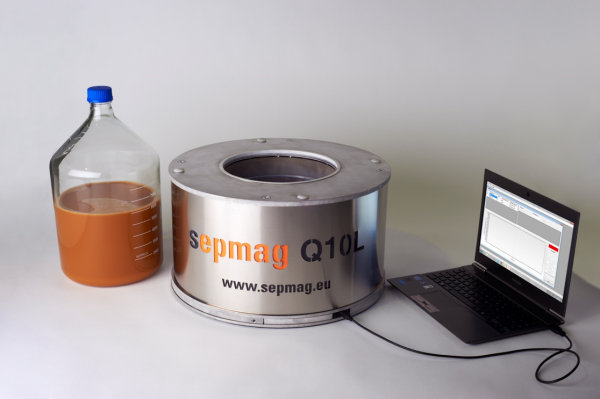Classic magnetic separation rack devices are designed such that both the magnetic field gradient and the magnetic state of the beads vary with the position of the beads. This means that once a process has been validated at a specific volume (i.e. your process has low material losses and no irreversible aggregation), it is difficult to change batch size without needing to re-validate the process.

In these devices, changing the volume means that the separation conditions (i.e. magnetic force vs. the distance of the beads from the magnet) are completely different from the original validated conditions.
This post is about biomagnetic separation with a magnetic separation rack, and how to scale-up this process. If you are interested in this topic, download our free ebook The Basic Guide to Scale-up Biomagnetic Separation Processes:
Solving magnetic force differences at variable volumes
One way to deal with differences of magnetic force with different production volumes in magnetic separation devices is to redesign the geometry of the device. But this also introduces a very different magnetic force map that will force the separation process to be re-validated with the new conditions. Neither increasing the volume with the original geometry nor redesigning the geometry of the classic magnetic separation rack will allow for lot-to-lot consistency when scaling up production.
The best option is to use advanced homogeneous biomagnetic separation devices such as the SEPMAG. Once you have correctly defined the optimal magnetic force in a homogeneous magnetic separation device, it is very simple to scale up production using the same validated conditions in a larger volume, with a different homogeneous magnetic separation system. It is important to note that the optimal magnetic force must be low enough to avoid clump formation (i.e. irreversible aggregation) and high enough to retain the beads while separating out the supernatant.
Typically when using the SEPMAG devices, you would start with the SEPMAG A system which allows production of small volumes of beads (from 1 – 250 milliliters); validate the proper conditions for separating your beads; then scale up using the SEPMAG Q system for lot volumes of 1 Liter or greater. The SEPMAG Q system would utilize the same magnetic force you deemed optimal in the SEPMAG A system for your particular process.
Don't forget to check these posts from our blog in order to get a deeper insight into the scaling-up of biomagnetic separation processes:
- Two conditions to have constant magnetic force regardless the lot volume
- How to deal with the 4 typical magnetic separation beads scale up problems?
- How to avoid In-lot inconsistency when scaling up biomagnetic separation processes
Check www.sepmag.eu/ebooks to access to FREE eBooks on the subject, or contact us. We will be glad to help you to achieve an efficient magnetic bead separation process!




